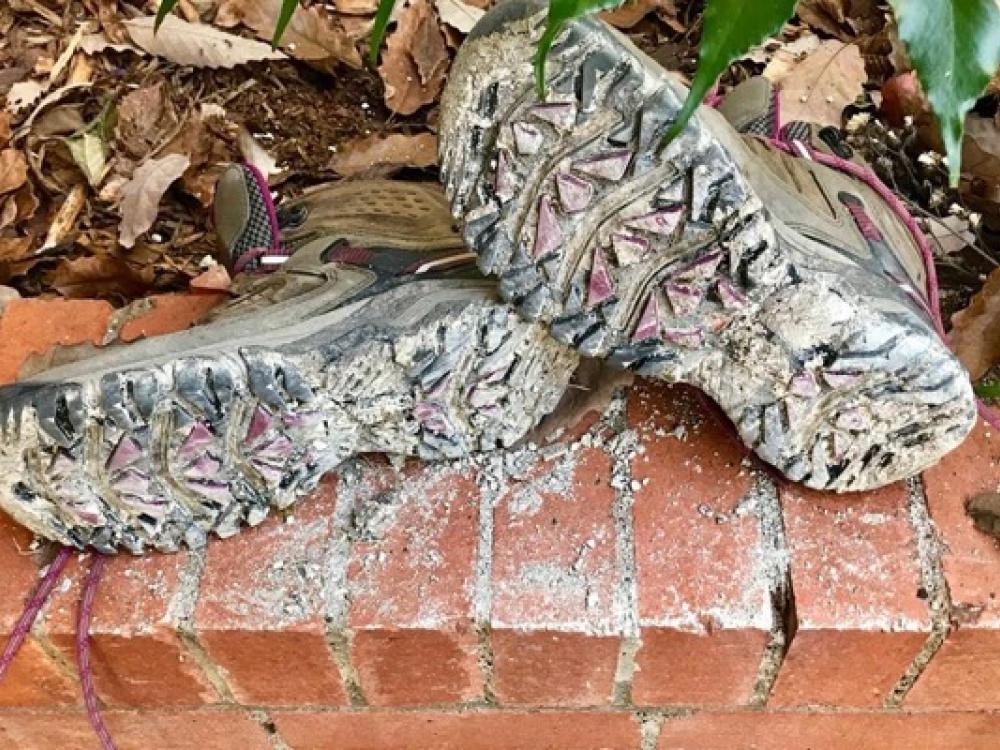
GSDFW reporter Amy Martin shares the thrill of becoming a certified nature expert. An intro to the program will be held Oct. 22 at 7:30 p.m. at the Texas A&M AgriLife Research and Extension Center in Dallas. Photo by Amy Martin.
Oct. 16, 2019
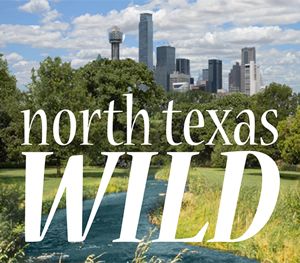 It’s the last class of the North Texas chapter’s Texas Master Naturalist program, which I enrolled in last fall.
It’s the last class of the North Texas chapter’s Texas Master Naturalist program, which I enrolled in last fall.
Sam Kieschnick, our Texas Parks and Wildlife chapter sponsor, motivator, mascot flashes an image upon the Powerpoint screen: the iconic “Circle of Life” crowning of Simba the lion by the mandrill Rafiki from the The Lion King.
Almost cherubic in his joy, he strides and gestures:
“You as master naturalists see this image differently from everybody else. You know the one thing most people don’t know. They don’t think about it. [Dramatic pause.] One of these animals belongs in the woods, the other on the savannah. They don’t live together. Sheesh!”
 Texas Master Naturalist instructor Sam Kieschnick rouses students to go forth and be helpful. Photo by Rose Mercer.
Texas Master Naturalist instructor Sam Kieschnick rouses students to go forth and be helpful. Photo by Rose Mercer.
It gets a big laugh. Lots of things Kieschnick says get a laugh. He urges us to grasp the air with a slightly homicidal rage when we invoke the name “privet.” Master naturalists spend a lot of time trying to exterminate the Chinese landscape shrub that infests vast stretches of open space in cities.
It’s not all funsies. Kieschnick goes off on great profound tangents, like the kismet of true love when a highly specialized insect finds the flower only it is capable of pollinating. Or extolling the thousands of complex functioning parts packed into a moth smaller than a grain of rice.
“The problem, then, is how to bring about a striving for harmony with land among a people many of whom have forgotten there is any such thing as land, among whom education and culture have become almost synonymous with landlessness.” - Aldo Leopold, A Sand County Almanac
DEEP DIVE
After an impressive 20 years of hosting master naturalists classes every spring in northwest Dallas, in 2018, the North Texas Master Naturalist chapter hosted a second class this fall. NTMN vice president Rose Mercer and new class director Laura Kimberly took on the yeoman task of organizing it, this time to the south at Mountain View College. All 50 seats filled immediately. I felt fortunate to be accepted.
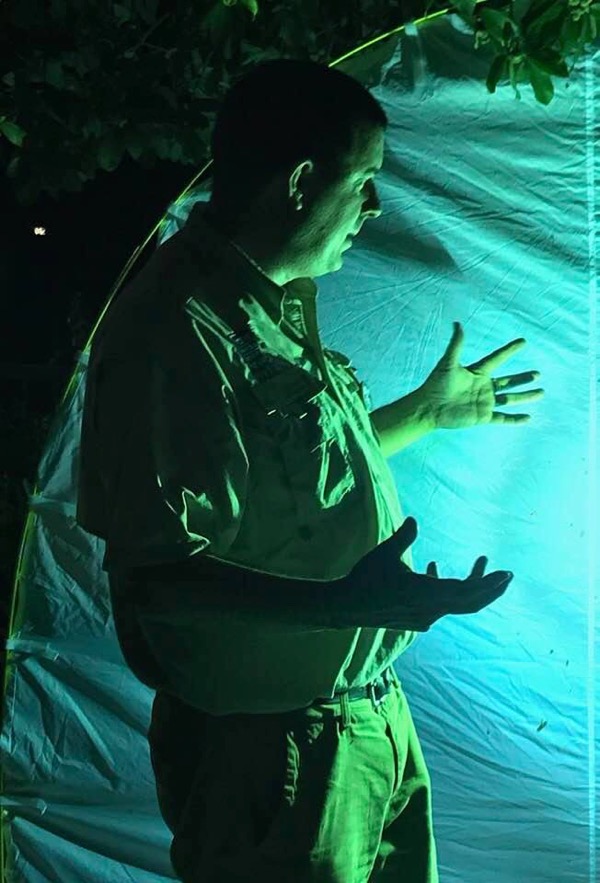 Sam Kieschnick of Texas Parks and Wildlife leads a mothing demonstration at the 2018 Texas Master Naturalist conference. Photo by Amy Martin.
Sam Kieschnick of Texas Parks and Wildlife leads a mothing demonstration at the 2018 Texas Master Naturalist conference. Photo by Amy Martin.
For 12 weeks, I listened to fascinating nature nerds extol their fields. Dan Northcut, a science teacher at St. Mark's School, trampled through eons of Texas geology, blowing our minds about ancient shallow seas and volcanoes.
Fun fact #1: The North Texas limestone that turns gooey when it rains is nothing like the razor-sharp limestone of parts of West Texas where it’s formed from ancient coral reefs.
David Finfrock (yes, that TV weather Finfrock) charged us up with the best weather-basics class I’d ever taken (and I’ve taken many), bringing alive the drama of weather. The fluctuating struggles between opposing forces of air pressure and temperature was so evocative of human society somehow.
Fun fact #2: Texas has two south winds, one on the eastern side that brings up moist gulf air and a dry western one that zooms in from the northern Mexico deserts.
The prairie is my passion. Brandon Belcher of The Nature Conservancy presented a powerful, informative class. Soil orders! Microtopography! Biomass production! Everything I’d learned in my 12 years of prairie management and then some, encapsulated into two hours, but arranged in an extremely clarifying way.
Fun fact #3: As pioneers exterminated pumas and wolves that preyed on bison, the grazing mammals modified from tight defensive groups to the iconic sprawling herds, changing the prairie ecology.
Tania Homayoun, a biologist with Texas Parks & Wildlife, tackled birds in another remarkably thorough class, from their environmental challenges to the fantastic engineering of their feathers and bones. Mike Merchant, an entomologist from Texas A&M, gained converts for the glorious world of bugs. We even ate some!
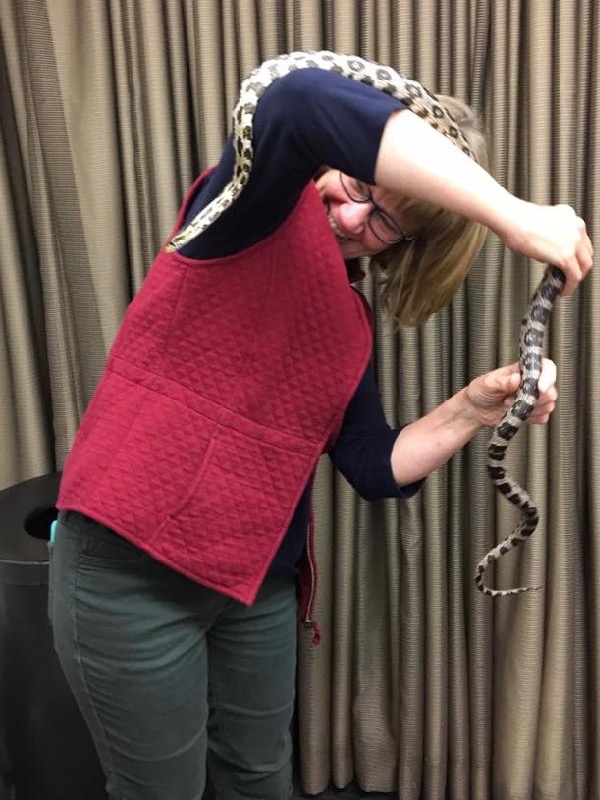 Kate Whidden gets up close and personal with a snake at a North Texas master naturalist class. Photo by Rose Mercer.
Kate Whidden gets up close and personal with a snake at a North Texas master naturalist class. Photo by Rose Mercer.
Fun fact #4: When migratory birds cross the Gulf of Mexico, it’s like running a 4-minute mile for 80 hours straight.
Arborist Steve Houser, a famed forest defender, enthralled with a quirky yet passionate tour de force on trees, complete with groaner cartoons. Roger Sanderson of Texas Discovery Gardens on snakes and reptiles, Naima Hill of Mountain View College on mammals, Meghan Peoples on taxonomy, Tiana Rehman of Botanical Research Institute of Texas on botany, Will Ford of Cedar Hill Parks & Recreation on urban ecology, Texas game warden Sergio Bazaldua on wildlife laws and regulations. It was teacher greatness.
Fun fact #5: Canine family poo tends to have pointed ends; feline poo ends are more rounded.
CLASSES FOR THE CURIOUS
Seem crazy to devote three hours in class once a week for three months? Use a textbook so large it could stop a car? A handful of weekend field trips to natural locales to put all the book learning in perspective? Hands-on class projects? It’s some serious schooling!
 Bug snacks served at entomology class. Photo by Rose Mercer.
Bug snacks served at entomology class. Photo by Rose Mercer.
Even so, for the past several years, North Texas Master Naturalist classes have been at full capacity. North Texas was the second Texas Master Naturalist chapter to be founded two decades ago and has the biggest number of active members. It is truly a kick-ass operation.
Deadline for applying to the spring NTMN classes is this Friday, Nov. 30. Application is available here.
Stay curious and always be learning - this is the very essence of Kieschnick and the Texas Master Naturalist program. The annual conference is an educational theme park of naturalist fun. In October 2019, it will be held in Rockwall. Some of us are already palpitating.
“Our ability to perceive quality in nature begins, as in art, with the pretty. It expands through successive stages of the beautiful to values as yet uncaptured by language.” -Aldo Leopold
EARTH AMBASSADORS
The more connected you are to the Earth the more connected you are to community. Knowledge presents a clear level of responsibility. The Texas Master Naturalist program encapsulates both perfectly.
Members statewide pour over 400,000 volunteer hours into being ambassadors for nature and the state of Texas. They educate at public events using trunks full of touchable natural items, sharing more than knowledge - sharing enthusiasm and wonder.
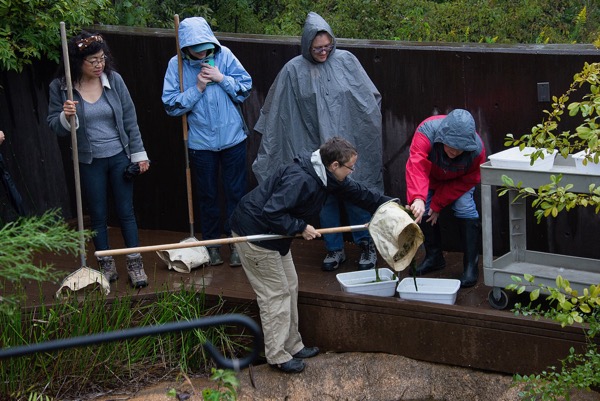 Master naturalist students on a field trip study the aquatic creatures in the wetlands of Trinity River Audubon Center. Photo by Bruce Stewart.
Master naturalist students on a field trip study the aquatic creatures in the wetlands of Trinity River Audubon Center. Photo by Bruce Stewart.
Master naturalists change the world one conversation at a time, explaining gently and without judgment alternatives to rodenticides that also poison owls who eat the dying rats and mice. They convey how leaving dead trees standing in the parks creates homes and food for songbirds, how letting the grass grow and get a little “weedy” makes for more fireflies.
Texas Master Naturalist volunteers restore nature in public places, from little pollinator gardens to large-scale prairie rehabilitation. They plug in native seeds and plants, pull out privet, carve out trails and gather trash. It can be strenuous. And rewarding. Bringing back life to the land can continue long after you’re gone. It’s the closest to immortality I’ll ever get.
Many thousands in North Texas have benefitted from NTMN work at Dallas parks such as Crawford Memorial, Harry Moss, Samuel Grand and around White Rock Lake; preserves like Cedar Ridge, Connemara, and Dogwood Canyon; and schools like Lakewood Elementary.
The icing on this nature cake? Each Texas Master Naturalist volunteer hour logged impresses granting agencies and Texas elected officials, leading to significantly more money for nature in Texas. Annual volunteer hours by this statewide armada of naturalist do-gooders is valued at more than $9 million.
“One of the penalties of an ecological education is that one lives alone in a world of wounds. Much of the damage inflicted on land is quite invisible to laymen.” - Aldo Leopold, A Sand County Almanac
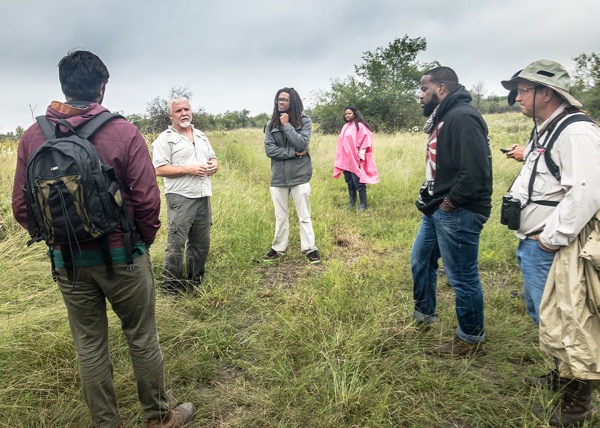 Richard Freiheit, Lake Lewisville Environmental Learning Area Restoration Manager, discusses prairie restoration with students on a field trip. Photo by Bruce Stewart.
Richard Freiheit, Lake Lewisville Environmental Learning Area Restoration Manager, discusses prairie restoration with students on a field trip. Photo by Bruce Stewart.
APATHY ANTIDOTE
I’ve completed my class and paid my dues. Also done: Eight hours of advanced training required each year to be an active Texas Master Naturalist. Plus the annual 40 volunteer hours, which seems like a lot, but I’d much rather work out in nature than work out in a gym.
At the December potluck-party and awards party, I’ll graduate and receive my “pin,” which looks a lot like an employee nametag. It’ll be official. I’m a Texas Master Naturalist.
It’s all uphill from here. Global warming. Rampant consumption of natural resources. Pollution with impunity. A rapaciousness that crushed the once abundant Blackland Prairie heritage to less than 1 percent of its range.
Master naturalists don’t delude themselves they can change all that. But they don’t languish in apathy and indulgence either. They take responsibility for their corner of the world - this pollinator garden, that greenbelt in a local park, the grounds of a nearby school.
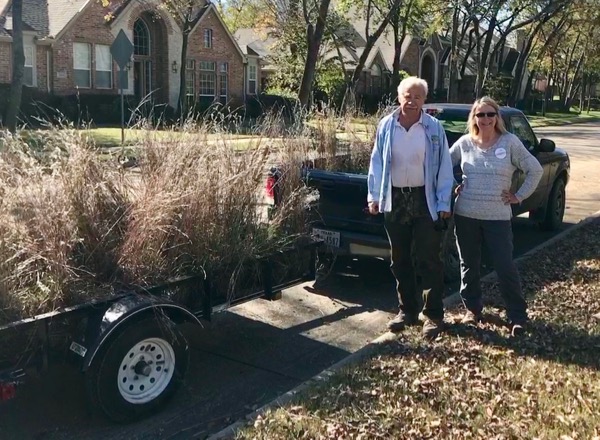 Amy Martin with Bob Mione, manager of Connemara Meadow Preserve, and a trailer full of native grasses rescued from a Blackland Prairie remnant soon to be developed. Courtesy of Connemara.
Amy Martin with Bob Mione, manager of Connemara Meadow Preserve, and a trailer full of native grasses rescued from a Blackland Prairie remnant soon to be developed. Courtesy of Connemara.
In their corner, what they do changes the lives of the wildlife, birds, reptiles, amphibians and insects that live there. It is everything to them. It improves the lives of humans who live near. All because a master naturalist truly believes, as John Muir stated, "When we try to pick out anything by itself, we find it hitched to everything else in the universe."
 The author’s car, aka the Seedmobile, with bags of native grass and forb seeds collected for planting in prairie restorations. Photo by Amy Martin.
The author’s car, aka the Seedmobile, with bags of native grass and forb seeds collected for planting in prairie restorations. Photo by Amy Martin.
Master naturalist classes transformed me. Hard to be depressed when you surround yourself with the human antidote to apathy. My all too desk-bound body is starting to show a bit of muscle. Dirt perpetually cakes my hiking boots. Life is good.
“We abuse land because we regard it as a commodity belonging to us. When we see land as a community to which we belong, we may begin to use it with love and respect.” - Aldo Leopold
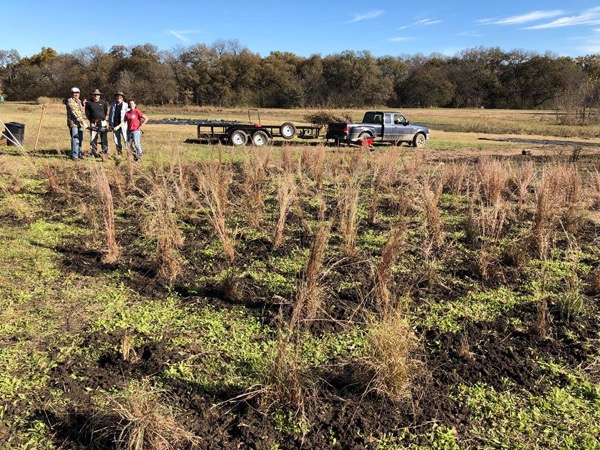 Plants rescued by master naturalists invigorate prairie being rehabilitated at Connemara Meadow Preserve. Courtesy of Connemara.
Plants rescued by master naturalists invigorate prairie being rehabilitated at Connemara Meadow Preserve. Courtesy of Connemara.
TEXAS MASTER NATURALIST PROGRAM
Since 1997, the Texas Master Naturalist program has grown to include 48 chapters and more than 10,800 volunteers serving Texas communities throughout 84 percent of the state’s counties. The mission of the program is to develop a corps of well-informed volunteers to provide education, outreach and service dedicated to the beneficial management of natural resources and natural areas within their communities for the state of Texas.
LOCAL CHAPTERS
The North Texas chapter of the Texas Master Naturalists program formed in 1998 and serves Dallas, Rockwall and Kaufman counties. It holds a spring certification program. Deadline for spring classes is Nov. 30. Application is available here.
The Blackland Prairie chapter covers Collin and Far North Dallas County. It holds a certification program in the spring in McKinney.
The Crosstimbers chapter was created in 1999 and serves Tarrant and Parker counties. It holds a 9-week fall certification class annually.
The Elm Fork Chapter encompasses Denton, Wise, and Cooke counties. It holds a spring certification program in the Denton area.
The Indian Trail chapter serves Ellis and Navarro counties. It holds a fall certification class.
The Rio Brazos chapter was formed in 2005 and covers Hood, Johnson and Somervell counties.
North Texas Master Naturalist Training Open House
About: An open house for the Texas Master Naturalist program. North Texas Master Naturalists will be accepting applications for its 2020 class from Oct. 1 to Nov. 30, 2019. Attend the gathering to learn more information on the training and our volunteer program. Master Naturalist Trainees receive in-depth education in wildlife and natural resource management, customized to focus on our local ecosystems.
When: Oct. 22, 2019, 7:30 p.m. to 8:30 p.m.
Where: Texas A&M AgriLife Research and Extension Center, 17360 Coit Rd, Dallas
This article originally published November 2018.
Stay up to date on everything green in North Texas, including the latest news and events! Sign up for the weekly Green Source DFW Newsletter! Follow us on Facebook and Twitter.









